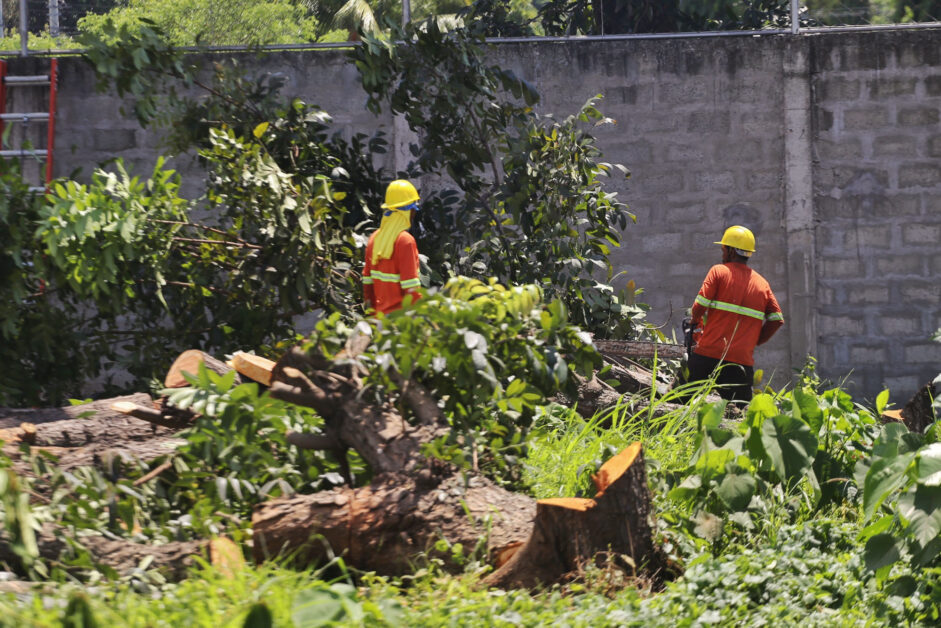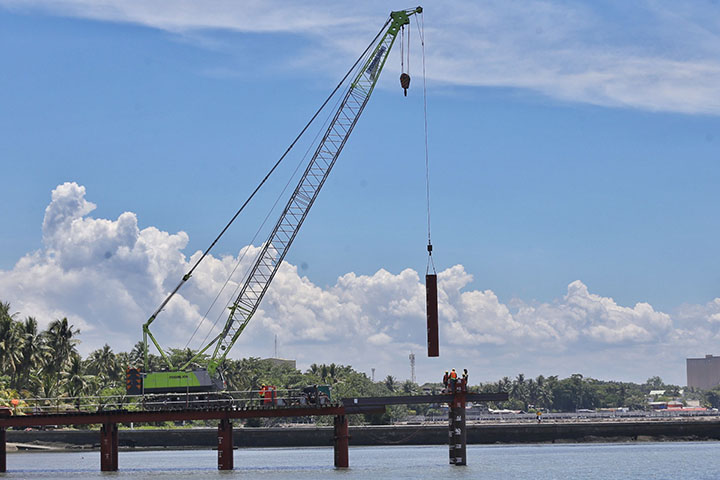DAVAO CITY (MindaNews / 22 May)—Local environmentalists here are demanding that the committee on environment and natural resources of the city council release the report on a series of hearings it conducted in October and November last year, which they claim could shed light on why construction has pushed through despite “environmental-related violations.”
 Workers cutting down trees along West Insular Village in Davao City to make way for the construction of the Samal Island-Davao City Connector Bridge. MindaNews file photo by MANMAN DEJETO
Workers cutting down trees along West Insular Village in Davao City to make way for the construction of the Samal Island-Davao City Connector Bridge. MindaNews file photo by MANMAN DEJETO
The controversy on the Samal Island – Davao City Connector (SIDC) Project sparked when more than 200 trees were cut on May 9 near the coast of West Insular Village, which is just a 25-minute ride away from the Davao City Hall.
The felling of trees apparently surprised Temujin “Tek” Ocampo, who led the conduct of the hearings as chair of the committee, and vowed to investigate the tree-cutting and seek the assistance of the City Environment and Natural Resources Office to find out if there were violations on the part of the regional office of the Department of Public Works and Highways (DPWH). If so, he vowed that the DPWH will “have to answer for it.”
But he admitted that it might be difficult to run after the DPWH since the city government “cannot just stop national projects, not unless the city government opposes it.”
Ocampo was a former reporter and news presenter of GMA Davao from the late 1990s until 2022, before he resigned to run as a city councilor under the first district of the city.
In a press conference Tuesday afternoon, lawyer Romeo Cabarde, a member of the Sustainable Davao Movement (SDM) and also vice chair of Amnesty International Philippines, said they will demand that Ocampo release the committee report so his colleagues in the Sangguniang Panlungsod will discuss it, to help clarify to the public how the bridge construction started and took place amid alleged environment-related violations.
“Once the committee report is released, at least the true stance of the city council on SIDC can be discussed in the plenary session… We will find out their position on the bridge, whether they really gave permission for their claims that there is already a resolution of no objection [to cut the trees], and whether there is a feasibility study?” Cabarde said in the vernacular.
He said that if no report on the hearings will be released, SDM will file a “writ of kalikasan” to certain national agencies and local government units (LGUs).
 Ongoing construction of the Samal-Davao bridge. MindaNews photo by MANMAN DEJETO
Ongoing construction of the Samal-Davao bridge. MindaNews photo by MANMAN DEJETO
The writ of Kalikasan is considered a legal remedy under Philippine law, providing protection of one’s constitutional right to a healthy environment. The writ of Kalikasan may be sought to deal with environmental damage of such magnitude that it threatens life, health, or property of inhabitants in two or more cities or provinces.
It derives its mandate from Article II, Section 16 of the 1987 Constitution, which the “state shall protect and advance the right of the people to a balanced and healthful ecology in accord with the rhythm and harmony of nature.”
The environmentalists said they make the Department of Environment and Natural Resources (DENR) answerable for “allowing trees to be cut.” They are also eyeing to file raps against the DPWH, the Protected Area Management Board (PAMB), contractor China Bridge and Road Corporation (CBRC), and possibly the local government units of the Island Garden City of Samal and Davao City.
“They eventually allowed the destruction of the environment,” Carbarde said.
Meanwhile, in a separate statement, the SDM urged stakeholders of the SIDC project to “suspend all tree-cutting activities and land clearing until genuine consultation and permitting processes with the LGU are undertaken by the project.”
They also wanted the City Council to review the current Environmental Management Plan (EMP) of the project, to conduct genuine consultation to the projects’ critical aspects and plans, among others.
Carmela Marie Santos, of the SDM secretariat and EcoTeneo director, argued that the trees felled near a hotel were a part of Barangay Hizon Marine Protected Area as stated and mapped in the City’s Comprehensive Land Use Plan for 2019 to 2028.
“The recent rampant tree-cutting activities of the SIDC Project or Davao-Samal bridge—around 200 trees on Davao side [and about 200 on Samal side] is cause for grave concern and much dismay,” Santos said, citing the SDM statement.
The SDM, however, clarified anew that they are supportive of the SIDC project “but not on its negative environmental implications,” like the cutting of trees and the damage it would cause to the Paradise Reef, which is said to be a “hidden treasure of Samal” considered by conservationists as an important “gene bank” of marine creatures. For the latter issue, the SDM has joined the movement to realign the bridge to spare the reef.
For Mark Peñalver, executive director of the Interfacing Development Interventions for Sustainability (IDIS), he urged the city government of Davao to exert its authority and not just dwell in its apparent passivity that it “cannot do anything because it is a national project.”
The Samal-Davao Bridge Project broke ground in October 2022, led by President Ferdinand Marcos Jr. and Vice President Sara Duterte.
The project is funded by a P23-billion loan agreement between the Chinese and Philippine governments, and is expected to be completed by 2027. The two-way, four-lane bridge aims to reduce the current 15-minute boat ride from Davao City to Samal Island to only five minutes, and eliminating the long queue at the pier. (Ian Carl Espinosa / MindaNews)